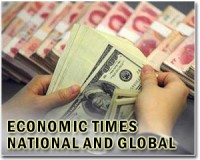 |
Paris (AFP) May 25, 2011 The rebirth of the Japanese economy following the devastating earthquake and tsunami in March is already underway, Prime Minister Naoto Kan said on Wednesday. "I state this with firm conviction that the rebirth of the Japanese economy has already been forcefully set in motion," Kan said a ceremony marking the 50th anniversary of the Organisation for Economic Cooperation and Development (OECD). The March 11 9.0-magnitude earthquake and tsunami left around 25,000 dead or missing, and with a subsequent emergency at the Fukushima Daiichi nuclear plant it plunged Japan into its worst post-war crisis. Many of the country's biggest companies have seen output and profits tumble while the economy plunged back into recession in January-March, with a second consecutive quarter of contraction. The OECD on Wednesday said it expected the Japanese economy would contract by 0.9 percent due to the disasters. It had previously forecast 1.7 percent growth for this year. "An economic recovery driven by reconstruction demand is expected for the second half of this year," Kan said, adding that most industrial production should fully recover in the next few months. The OECD predicts a strong rebound for the Japanese economy next year with 2.2 percent growth. "Given the experience of past disasters in Japan and elsewhere, the large negative impact ... in the first and second quarters is expected to be reversed quickly as reconstruction efforts get underway," the OECD said in its latest Economic Outlook report. Japan's central bank chief also noted Wednesday there were already signs of recovery. An increasing number of plants are resuming production while there are signs of improved sales at department stores, snapping a plunge in consumer spending immediately after the quake, Bank of Japan Governor Masaaki Shirakawa said.
earlier related report An increasing number of plants are resuming production while there are signs of improved sales at department stores, snapping a plunge in consumer spending immediately after the quake, Bank of Japan Governor Masaaki Shirakawa said. "Therefore, in the second half of fiscal 2011, the sense of recovery will be somewhat more noticeable, although it will fall short of a V-shaped recovery," he told an economic forum in Tokyo. The 9.0-magnitude earthquake and tsunami left around 25,000 dead or missing, and with a subsequent emergency at the Fukushima Daiichi nuclear plant it plunged Japan into its worst post-war crisis. Many of the country's biggest companies saw profits tumble in the quarter while the economy plunged back into recession in January-March, with a second consecutive quarter of contraction. Industrial output saw its biggest ever fall and spending plunged as consumer and business confidence took a tumble. Shirakawa said Japan's most pressing short-term challenge was to resolve supply constraints as early as possible. "The recent sharp and substantial economic plunge is similar to that following the failure of Lehman Brothers but different in terms of its mechanism: the recent downward pressure is caused by a supply-side shock," he said. Japan's economy contracted for four straight quarters during the global economic downturn following the collapse of Wall Street titan Lehman Brothers in 2008. But Shirakawa said the main difference was that while output was hit badly by the March 11 disaster, demand had not disappeared. "The destruction of factories led to disruptions in the supply chains of parts and materials, which affected production not only in disaster-stricken areas but also a wide range of non-affected areas," he added. Shirakawa said the BoJ was considering whether there is further room to expand its special lending facility to boost loans to growth sectors, in light of the damage done to the economy by the earthquake and tsunami. "It is necessary to regard reconstruction in the quake-affected areas as a starting point to strengthening growth potential," he said. Japan's central bank decided last week to keep the size of its asset-purchase program unchanged at 10 trillion yen and to maintain its unsecured overnight call loan rate target in the current zero to 0.1 percent range.
Share This Article With Planet Earth
Related Links The Economy
 Shunned by banks, small China firms hit pawn shops
Shunned by banks, small China firms hit pawn shopsShanghai (AFP) May 24, 2011 China has some of the biggest banks in the world, but they turned their back on Jacky Wang when his small decorating firm needed a loan. So like many Chinese entrepreneurs, he turned to a pawn shop. Chinese authorities have battled to rein in a massive boom in lending over the past two years, but the credit wave never reached Wang and millions of entrepreneurs like him. "The banks' requ ... read more |
|
| The content herein, unless otherwise known to be public domain, are Copyright 1995-2010 - SpaceDaily. AFP and UPI Wire Stories are copyright Agence France-Presse and United Press International. ESA Portal Reports are copyright European Space Agency. All NASA sourced material is public domain. Additional copyrights may apply in whole or part to other bona fide parties. Advertising does not imply endorsement,agreement or approval of any opinions, statements or information provided by SpaceDaily on any Web page published or hosted by SpaceDaily. Privacy Statement |